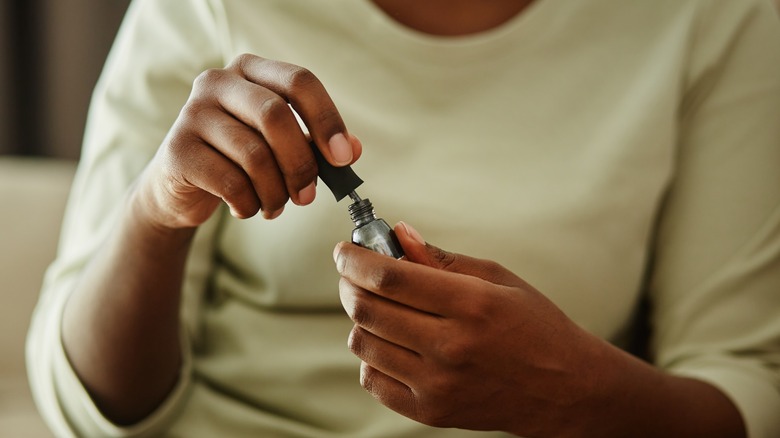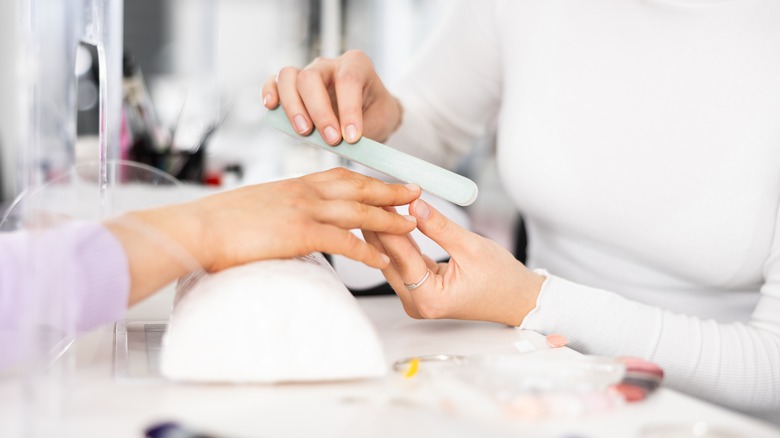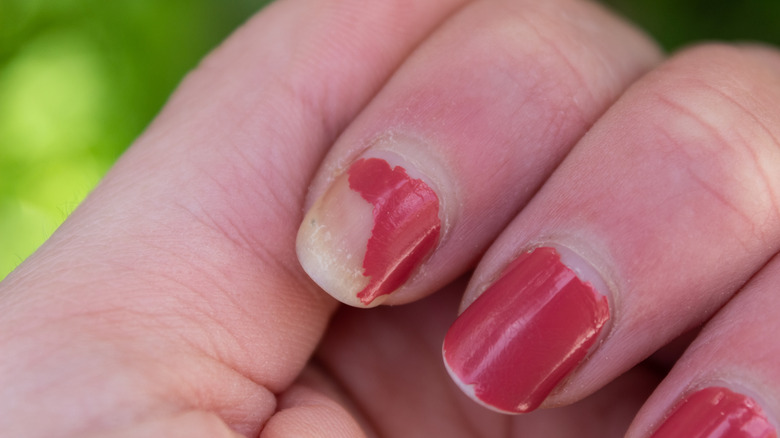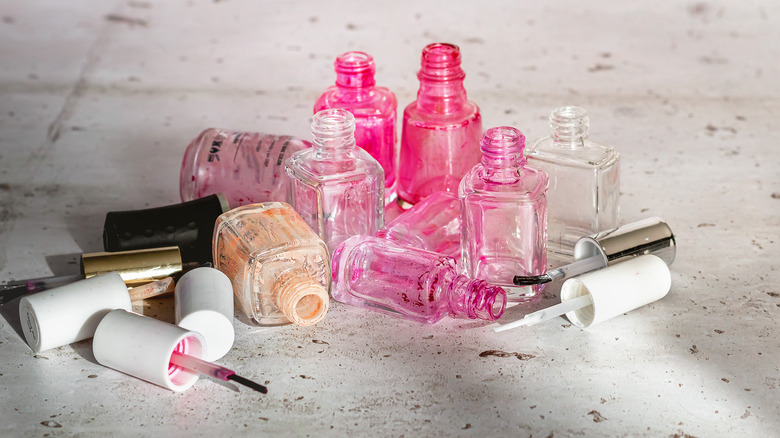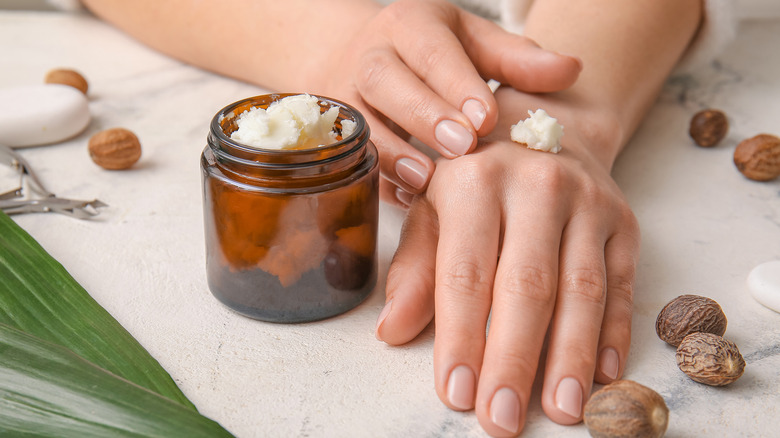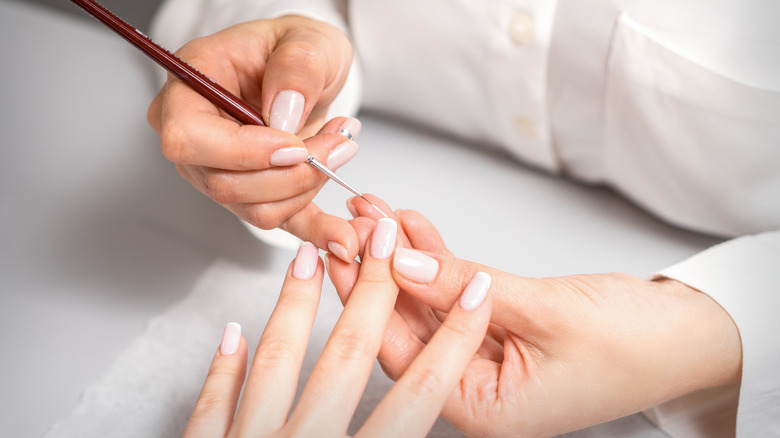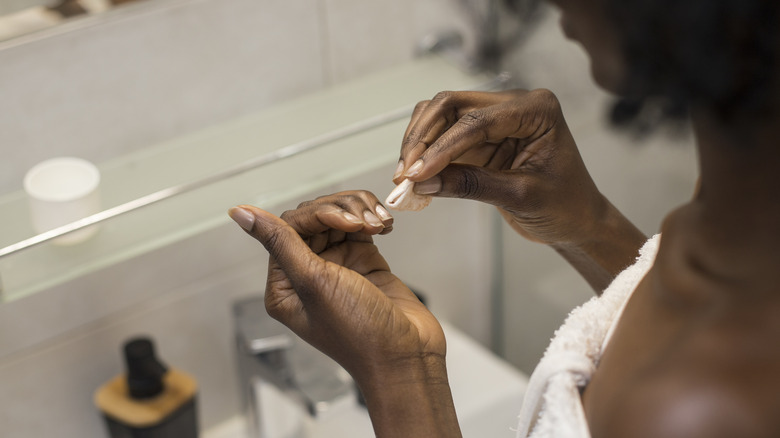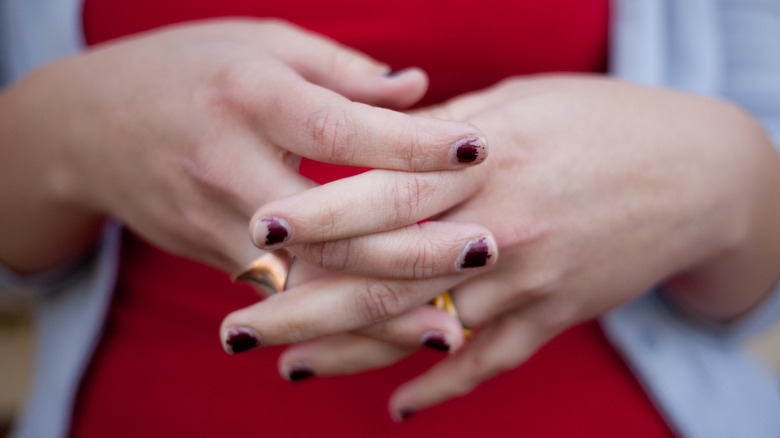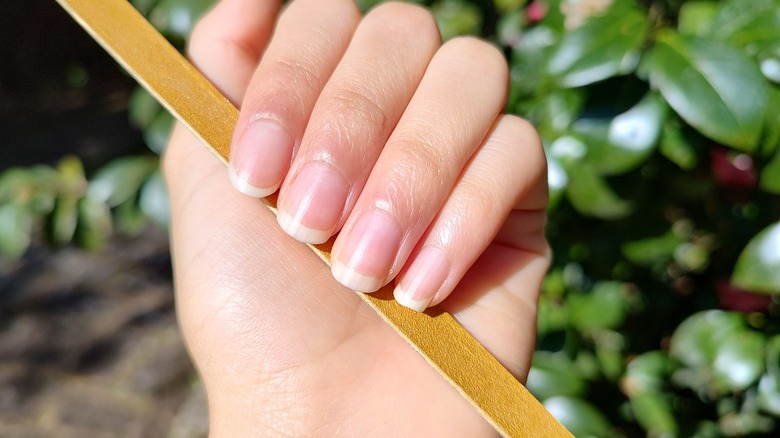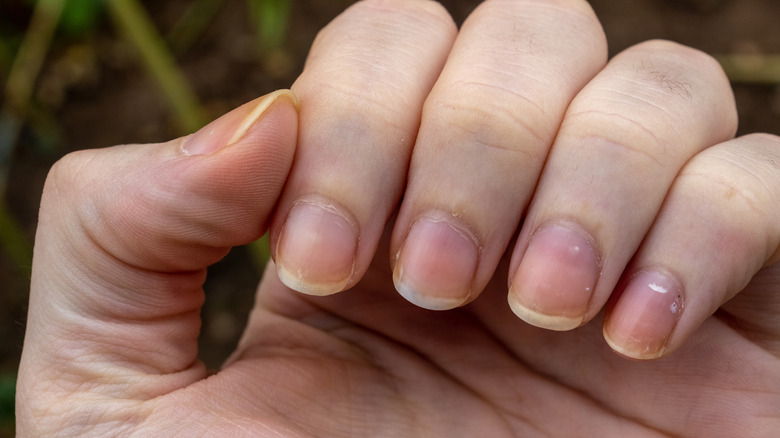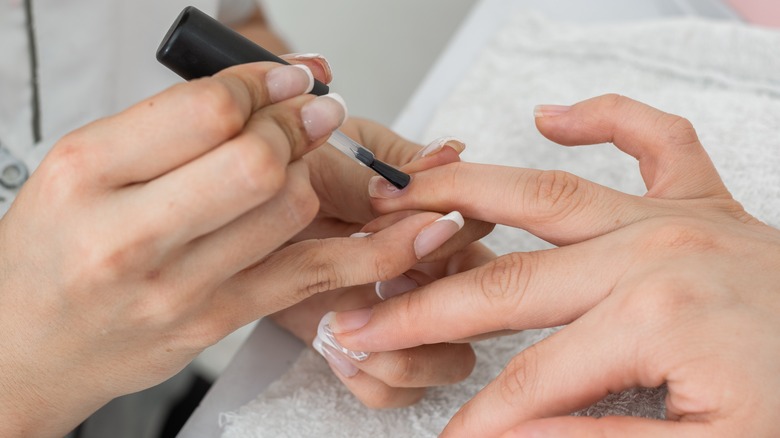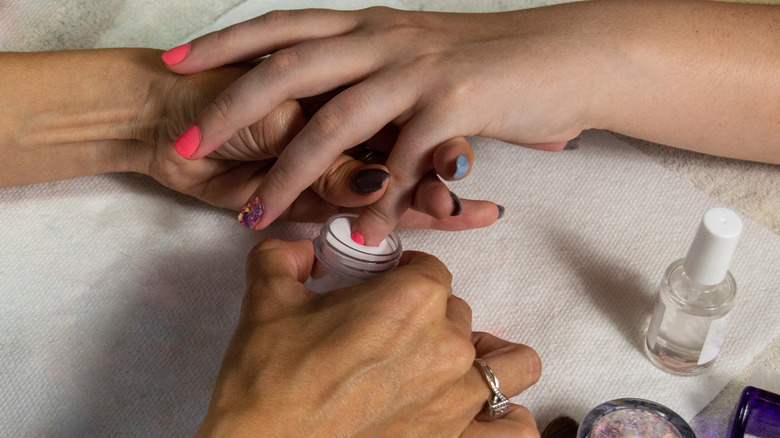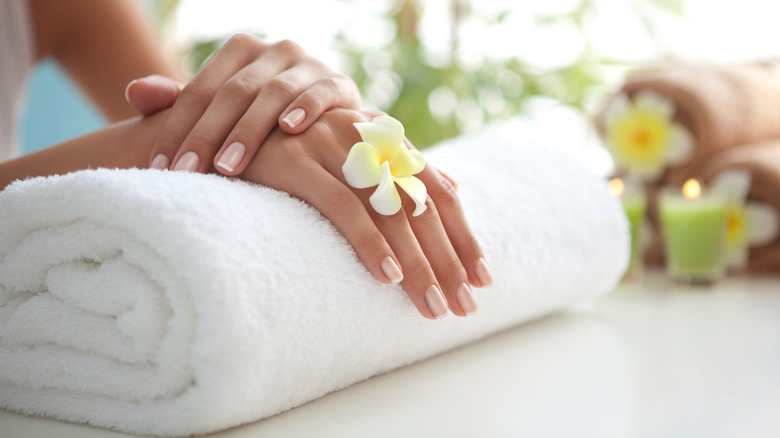10 Reasons You Should Start Ignoring Your Nail Polish
If you feel incomplete without a fresh-from-the-salon manicure, we don't blame you one bit. A new set of nails can make anyone feel put together enough to take on the world. But if you can't even remember what your natural nails look like, it might be time to lay the polish to rest for at least a little while.
As much as we all love nail polish, the reality is it's not a great practice to wear it all the time. It seems innocuous on the surface — after all, what harm could a little bottle of color cause? Well, enough to make us want to put it away sometimes. Aside from containing potentially toxic ingredients (and potential allergens), nail polish isn't great for the environment. Plus, keeping your nails covered in color all the time can prevent them from getting some much-needed TLC.
If you're about to throw your phone in protest, don't! We're not saying to lay off the polish permanently. Just give your nails a break from the polish routine every once in a while. Need more convincing? Here are 10 reasons you should start ignoring your nail polish and a couple of tips for showing your nails some love during this polish-free phase.
Nail polish can contain toxins
It probably doesn't come as much of a surprise that your standard store-bought nail polish can contain toxins, as can many products in the beauty industry. Among them are formaldehyde, which has been recognized as a substance that could cause cancer, and toluene, formaldehyde resin, and dibutyl phthalate, which can cause allergic reactions. It's worth noting that the substances in nail polish can be absorbed into the body, though it's unclear whether the amount absorbed by the body should cause concern.
Wondering about non-toxic polishes, or other kinds of manicures you may get at the salon? Your favorite gel manicure may pose an allergic reaction risk, and the UV lamps you use to set the gel pose potential cancer-causing concerns. Non-toxic polishes, on the other hand, can be difficult to suss out. According to Harvard Medical School, you're going to want to look for polishes that say they're "five-free" — this will mean they don't have formaldehyde, toluene, dibutyl phthalate, formaldehyde resin, and camphor, all of which are cause for potential concern. However, the jury's still out on whether standard polishes are toxic enough to merit a full switch to non-toxic polishes.
It's potentially hazardous if you work in the food industry
If you work (or have worked) in the food service industry at all, we wouldn't be surprised if you've been advised to lay off the polish during your working shifts. While nail polish certainly doesn't seem like a food hazard on the surface, the reality is that even the most benign polish poses a risk if it comes into contact with food during your shift. It doesn't necessarily pose a safety concern, but it can raise some red flags when it comes to hygiene.
Food safety certifications vary by state, but will generally require that you wear disposable gloves when handling food if you're sporting nail polish, a salon manicure, or even fake nails. The reason is simple and often overlooked — nail polish has the potential to flake off into whatever food you're preparing, and fake nails could even fall off in the food. So, if you do choose to wear nail polish or fake nails to your food service industry job, don't be surprised if your manager asks you to don a pair of gloves for your shift. Or you could always forego the polish for your shift and save it for vacation time.
Plus, it's not very eco-friendly
What do you typically do with your empty (or unusable) nail polish bottles? No shade if you throw them in the garbage (we do too), meaning it probably doesn't come as a surprise to you that nail polish bottles tend to end up in landfills because they're not recyclable. Aside from just ending up in a landfill, though, many cities also classify nail polish as a hazardous waste product that poses many environmental risks.
Even the production of nail polish poses a concern to environmental advocates. For example, mica, a commonly used ingredient in nail polish, has been found to contaminate waterways where it's mined in India. Labor conditions are also often not ideal for mica miners and pose many health and safety hazards to these laborers. Again, we don't say this to guilt you, but awareness is the first step to creating lasting change.
Using nail polish less frequently means the polish you have right now will last longer, take longer to end up in a landfill, and won't need to be replaced as soon. Or if you're feeling particularly convicted, you could step away from the polish permanently as an eco-conscious move.
Your nails need some moisture
If you've heard that it's important for your nails to "breathe" between manicures, you're far from alone. We're here to tell you that this is more myth than fact — your nails don't really need to breathe, as they get all the air and nutrients they need from your blood and not the environment. What they do need, however, is something they definitely don't get if you have polish on them 24/7. That's right, friends — we're talking about moisturizer.
Have you ever been encouraged to moisturize your nails? It's okay if you haven't. While letting them "breathe" has long been seen as a necessity, giving your nails the moisture they need is rarely a topic of discussion. Nail cycling (taking a break between manis) is a great way to make sure your nails get the moisture they need to stay healthy. If you're wondering how to moisturize your nails, it's easy — and no, you don't need to buy a special nail moisturizer. Just use whatever hand lotion or cream you already have on hand. For bonus points, massage some petroleum jelly, vitamin E, or cuticle cream into your nails at night to maximize their health.
Polish can trap bacteria
When your nails are cracked, damaged, or otherwise unsightly, your first impulse is probably to cover them with a coat or two of your favorite polish. We hardly blame you. It's no picnic shaking a hand or handing over a credit card when your nails look less than presentable. But we have a sad truth for you, friend — that quick-fix polish solution may actually be doing you more harm than good.
The bad news is that nail polish provides a nice little cover for bacteria, allowing them to flourish on your nails. While this probably isn't a huge issue for your average polish days, it can pose a big risk if your fingers have been through the wringer recently — say, if you've picked at one too many hangnails or you're noticing signs of inflammation in your cuticles. While wearing nail polish isn't guaranteed to exacerbate the problem, it certainly poses risks, as it gives the bacteria an environment in which it can thrive.
So if you're noticing any signs that your nail health might be compromised, we'd advise laying off the polish at least until your nails seem back to normal. Plus, who knows? Once your natural nails are healthy again, you may like them so much that you don't want to go back to polish.
Nail polish remover also poses potential problems
Listen, we've all spent countless hours by now scrubbing at our nails to remove the polish we carefully applied just days earlier. Eventually it chips and flakes, so we grab the bottle of remover, scrub it on with a cotton ball, and often immediately apply another coat of polish after. While many removers nowadays claim to strengthen your nails, the reality is that scrubbing your nails with a chemical substance isn't going to be good for them.
Acetone, an active ingredient found in many nail polish removers, isn't necessarily harmful in and of itself (unless you accidentally ingest it), but it does your nails no favors. Rubbing your nails with acetone can dehydrate the surface of your nails and irritate your cuticles. And before you ask, no, natural nail polish removers often aren't much better. They'll still contain chemicals, and since they tend to exclude acetone, your nails will require even more scrubbing to remove the polish, thus allowing your nails to incur more damage. If you notice dry, cracked, or bleeding cuticles shortly after using acetone-based nail polish remover, the remover could very well be the culprit. Give your nails a break from the remover and see if that helps. In the meantime, don't forget to give them plenty of moisture.
Let's be honest: DIY nails are hard to keep perfect
Are you an at-home nail aficionado? If so, you probably know that even the most well-applied DIY manicures aren't easy to keep perfect. Especially if you regularly do work with your hands beyond the typical desk job, you'll probably find your polish chipping off after just a day or two (even with a good top coat), probably prompting you to scrub the polish off and reapply only to have the problem repeat itself another few days later. It's a seemingly endless cycle — unless you forego the polish, that is.
While we all love a fresh DIY manicure, you probably don't love the endless applying and reapplying. If that's the case, why not take a break from the color for a while? It may be weird to look at your naked nails at first, but you'll get used to them over time. You may even find some freedom in not needing to apply polish on the regular. When you need just a little put-together touch, you can opt for a coat of clear polish every now and then — this will give your nails a polished look (pun intended) without the upkeep a traditional DIY mani calls for.
Naked nails can tell you about your health
Did you know that your nails can tell you about your health? That's right — the texture and appearance of your nails can give you some valuable clues as to how the rest of your body is doing, but not if they're constantly covered in polish. Try wearing your natural nails for a week or two and pay attention to their appearance for what could be some eye-opening insights into how your health is faring.
Pay attention to any lines, ridges, white spots, or discoloration on your nails. According to Cleveland Clinic, your nails can hint at anything from too much stress to psoriasis, arthritis, and even kidney disease. Ridged nails, white spots, and horizontal lines are all possible signs of kidney disease, while white spots, black lines, loosening of your nail, and redness may point to psoriasis. Some darker discolorations could be as innocuous as a mole, or they could be a sign of melanoma. If you notice any change in the appearance or feel of your nail, and it's persistent, it's best to check in with your dermatologist to stay on the safe side.
Polish can contribute to yellowing nails
Your yellow nails could be caused by a variety of factors. Unfortunately, some of these reasons are more sinister than others. According to Healthline, yellow nails could be a sign of diabetes, psoriasis, thyroid conditions, lung conditions, or even skin cancer. If your yellow nails just won't quit and you can't get them to return to a normal color, we'd advise seeing a dermatologist.
Sometimes, though, your yellowing nails could be caused by the nail polish you're wearing, especially if you prefer darker colors. Instead of covering your yellow nails with more dark polish, lay off the polish for a bit and see if that solves the problem. If your nail is yellow as it grows in, that's likely a sign of an underlying problem; if not, polish is probably the culprit.
There are some home remedies you can try to get your yellow nails looking nice and neat again. Kester Black has a few recommendations, like applying lemon juice, vitamin E, or tea tree oil to your nails to help with yellowing. If you refuse to give up the dark polish but know that it's contributing to your yellowing, there may be a simple solution: Apply a nice base coat to the surface of your nail before adding color, so the color doesn't come into direct contact with your nail.
It can also contribute to keratin granulation
Never heard of keratin granulation? Even if you don't know what it is, we wouldn't be surprised if you've experienced it at least once. Keratin granulation happens when your nails become dehydrated (remember how we just talked about nails needing moisture?), causing unsightly white spots to appear on the surface of your nail. Keratin granulation looks about as good as it sounds (hint: not very), and if you notice it on your nails, your first impulse is probably to cover it up with another coat of polish, but this is the last thing you should do.
According to Foot Right Podiatry, there are a few things you can do to get your nails looking back to normal again. You could simply leave your nails bare and wait for the new nail to grow in — new growth shouldn't have the appearance of keratin spots. In the meantime, you could try to reduce them by giving your nails some much-needed moisture. In dire cases, you could try to buff some spots off the surface of your nail, though you'll want to be careful of over-buffing, as that could cause further damage.
Are there any better-for-you alternatives?
Any frequenter to a nail salon knows that there's no one-size-fits-all manicure option. Gel has become popular over the years due to its durability, while dip powder is a nail color technique that's recently taking salons by storm. Maybe you typically just opt for regular polish. If you're wanting to look into better alternatives to your traditional mani, there are a few things to keep in mind the next time you go to the salon.
The first (and likely easiest) way to get a better-for-you mani is to try to find a non-toxic nail salon near you. These salons will frequently use polishes that are free of formaldehyde, toluene, and dibutyl phthalate (the "big three"), and they'll typically have acetone-free nail polish remover, as well.
When it comes to deciding between a dip manicure or a gel manicure, dip manicures are frequently said to be safer because they don't require a UV light to cure them. However, you'll want to make sure your nail technician isn't dipping all their clients' nails in the same jar of dip powder, as this practice has the potential to spread bacteria from client to client.
How to keep your natural nails strong
By now, you may be sold on the idea of taking a polish break. But when you do, you'll want to make sure you're taking care of your nails and keeping them healthy and strong, so you can get the color back on ASAP. As we've already said, you'll want to keep them moisturized — we suggest investing in a good cuticle oil if you don't have one already. You'll also want to keep your nails clean and trimmed to prevent bacteria from building up underneath your nail. Mayo Clinic also suggests talking to your doctor about biotin supplements, which could be especially beneficial if your nails are weak or brittle.
If you simply can't forego the nail decor, there are a couple of last-ditch options at your disposal. Press-on nail stickers aren't at all hard to find nowadays, and though their staying power doesn't tend to be the best, the fact that they peel off easily means they don't do a ton of damage to your nail (especially considering you don't need to remove them with acetone). If you're going to be committed to the natural nail look, however, make sure you protect your nails at all costs — this means wearing gloves when washing dishes, cleaning, or doing other hand-heavy activities and giving your nails plenty of moisture.
